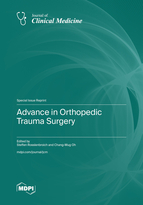Advance in Orthopedic Trauma Surgery
A special issue of Journal of Clinical Medicine (ISSN 2077-0383). This special issue belongs to the section "Orthopedics".
Deadline for manuscript submissions: closed (1 February 2023) | Viewed by 23164
Special Issue Editors
Interests: trauma surgery; distraction osteogenesis; deformity correction; external fixators; tibia; femoral fractures; tibial fractures; fracture healing; non-union; fracture associated infections; spine-trauma; pelvic-trauma
Interests: fracture; trauma surgery; pediatric orthopedics; distraction osteogenesis; deformity correction; external fixators; tibia; femoral fractures; tibial fractures; fracture healing
Special Issue Information
Dear Colleagues,
The field of orthopedic trauma has always been a discipline with rapid innovations and creative evolution. We see an evolution in every facet of orthopedic surgery, from the transformation of implant design and biomechanical understanding to the understanding and monitoring of fracture healing and the management of complications. New technological alternatives enable us to limit the soft-tissue impairment using minimally invasive approaches and to reach the highest safety standards for our patients. However, outside the operating room, there are new ways of educating younger colleagues using these new technologies.
Continual progress is being made in the fields of implant design and implant coating for osseous integration or infection prophylaxis. There is a trend towards interdisciplinary approaches to managing complex injuries involving soft-tissue and osseous structures and their complications in order to meet the patients’ needs, since the demographic trends are leading to older and older patients with frequent co-morbidities. Digitalization offers us the possibility of connecting with cooperating disciplines in a time-saving way to individualize and optimize therapy for our patients, even in a rural of conflict-based infrastructures lacking experts from certain disciplines.
This Special Issue addresses the aforementioned advances in orthopedic trauma surgery based on a combination of original research and review papers.
Dr. Steffen Rosslenbroich
Prof. Dr. Chang-Wug Oh
Guest Editors
Manuscript Submission Information
Manuscripts should be submitted online at www.mdpi.com by registering and logging in to this website. Once you are registered, click here to go to the submission form. Manuscripts can be submitted until the deadline. All submissions that pass pre-check are peer-reviewed. Accepted papers will be published continuously in the journal (as soon as accepted) and will be listed together on the special issue website. Research articles, review articles as well as short communications are invited. For planned papers, a title and short abstract (about 100 words) can be sent to the Editorial Office for announcement on this website.
Submitted manuscripts should not have been published previously, nor be under consideration for publication elsewhere (except conference proceedings papers). All manuscripts are thoroughly refereed through a single-blind peer-review process. A guide for authors and other relevant information for submission of manuscripts is available on the Instructions for Authors page. Journal of Clinical Medicine is an international peer-reviewed open access semimonthly journal published by MDPI.
Please visit the Instructions for Authors page before submitting a manuscript. The Article Processing Charge (APC) for publication in this open access journal is 2600 CHF (Swiss Francs). Submitted papers should be well formatted and use good English. Authors may use MDPI's English editing service prior to publication or during author revisions.
Keywords
- minimally invasive surgery
- smart implants
- coating technologies
- fracture monitoring
- interdisciplinary treatment
- telemedicine
- digitalization in orthopedic trauma
- digitalization in orthopedic education








